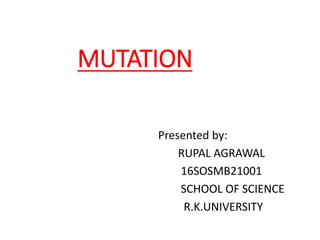
Mutation
- 1. MUTATION Presented by: RUPAL AGRAWAL 16SOSMB21001 SCHOOL OF SCIENCE R.K.UNIVERSITY
- 2. INTRODUCTION: • A mutation is the permanent alteration of the nucleotide sequence of the genome of an organism, virus, or extra chromosomal DNA or other genetic elements. • Most mutations are the result of error during replication process/ error during DNA repair. • CLASSES:
- 4. Types of Mutation: 1. Gene mutation • Point mutation - silent - Mis-sense - Non-sense • Frameshift mutation -Addition - Deletion 2. Chromosome mutation • Deletion • Duplication • Inversion • Translocation • Insertion
- 10. The basis of mutational change: How do mutations arise? If mutations are induced in response to selection they will occur only in the final generation of cells – the ones that are exposed to phage If mutations occur randomly they will occur throughout population growth – i.e., prior to selection grow up population without selection (e.g. no bacteriophage) expose the population to selection and count the number of mutant individuals (colonies) Directed/Adaption hypothesis
- 11. LURIA- DELBRUCK EXPERIMENT (Fluctuation test) They tested that weather mutations are independent of natural selection or they are directed by the selection.
- 12. The basis of mutational change: How do mutations arise? Luria and Delbruck started populations of bacteria from a small number of cells… … and allowed them to grow up to reach a large number of cells (~10 billion) then determined the number of bacteriophage resistant cells: If the virus resistance is not due to random gene mutation, then each plate should contain the same number of colonies. Each level represents a round of cell division bacteriophage on the plate kill sensitive cells
- 13. Result: • They found that the number of resistant colonies on each plate varied drastically. • CONCLUSION: They proposed that these results could be explained by the occurrence of a constant rate of random mutation in each generation of bacterial growth in the initial culture tube.
- 14. NEWCOMBE EXPERIMENT This experiment was used to determine wheather mutations which make E.coli resistant to T2 phages are spontaneous or whether exposure of the bacteria to the phage induces the resistance to arise in cells.
- 15. 1. E.coli culture was examined and the colony count of surviving colonies was counted. 2. One set of bacterial plate was exposed to T2 virus, and the other set was respread. If mutations are induced by exposure to the T2 bacteriophage then approximately the same number of mutants are expected to appear on each plate, regardless of respreading the plate. However, if the resistance to the T2 phage in E.coli was a result of spontaneous mutations during cell divisions prior to plating, then the respread plate would be expected to have a higher number of mutants.
- 16. OBSERVATION: • It was observed that the unspread plate had less T2 resistant colonies, while the respread plate had more mutant colonies. • This variation in the number of mutants on each plate leads to the conclusion that the mutation causing the resistance to bacteriophage T2 in the E.coli arosed spontaneously.
- 17. The Lederberg experiment In 1952, Esther and Joshua Lederberg performed an experiment that helped to show that many mutations are random, not directed.
- 18. • The hypothesis for the experiment is that antibiotic resistant strains of bacteria surviving an application of antibiotics had the resistance before their exposure to the antibiotics, not as a result of the exposure. • Steps: 1. Bacteria are spread out on a plate, called the "original plate.“ 2. They are allowed to grow into several different colonies.
- 19. 3. This layout of colonies is stamped from the original plate on to a new plate that contains antibiotic penicillin. 4. Colonies X and Y on the stamped plate survived. They must carry a mutation for penicillin resistance.
- 20. RESULT: • When the original plate is washed with penicillin, the same colonies (those in position X and Y) live — even though these colonies on the original plate have never encountered penicillin before. CONCLUSION: • the penicillin-resistant bacteria were there in the population before they encountered penicillin. They did not evolve resistance in response to exposure to the antibiotic. So the mutations are random and not directed.